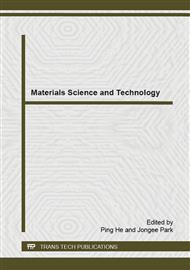p.138
p.142
p.148
p.154
p.160
p.165
p.171
p.175
p.183
Technological Features of Obtaining of Nanostructured Coatings on TiNi Base by Magnetron Sputtering
Abstract:
Using the methods of experimental design made the choice determining factors for the calculation of modes magnetron sputtering coating SME steel 321H; received mathematical-statistical model that relates the performance criteria with the main parameters of the process. Studies on developing the technology of magnetron sputtering materials with shape memory TiNi-based study of the structure and formed surface layers showed that the recommended spraying regimes provided obtain a homogeneous quality of the surface layer with a grain size of 15 nm to 50 nm, chemical and phase composition which provides the memory effect.
Info:
Periodical:
Pages:
160-164
Citation:
Online since:
December 2014
Authors:
Price:
Сopyright:
© 2015 Trans Tech Publications Ltd. All Rights Reserved
Share:
Citation:


